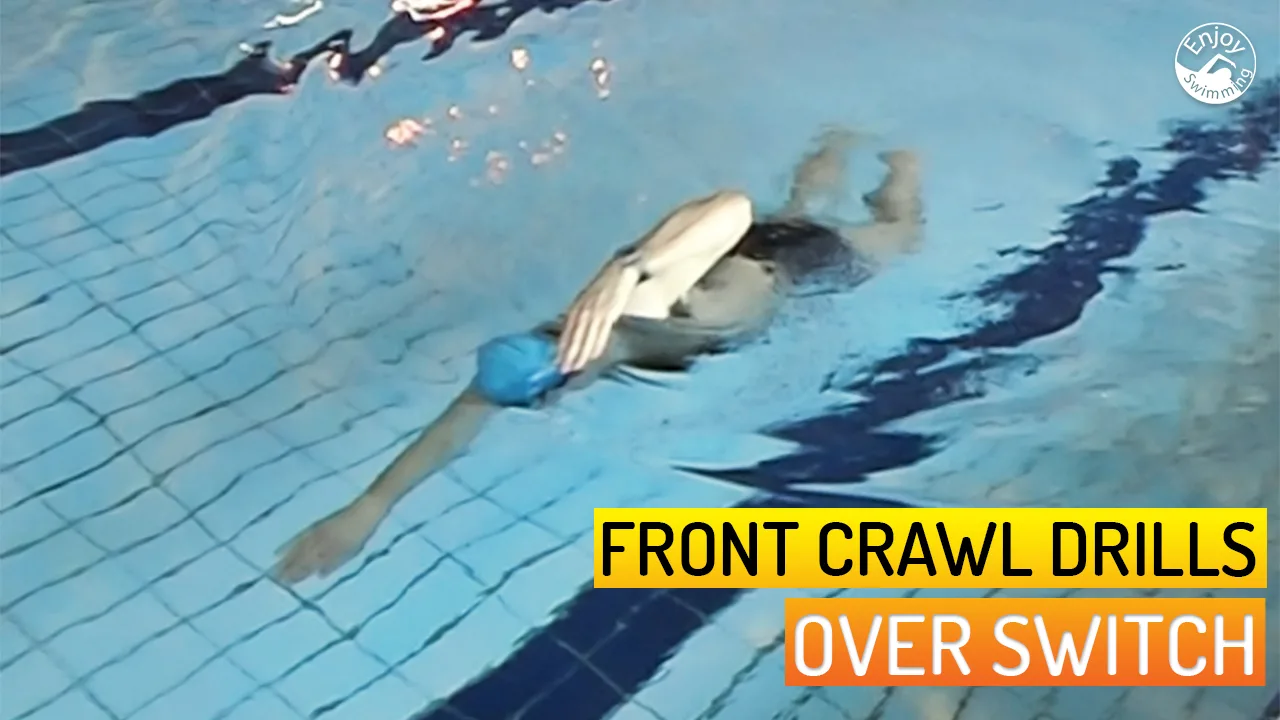Over Switch is the last swimming drill in our series of drills for the front crawl/freestyle stroke.
It lets you practice an early entry of the hand into the water during the arm recovery.

This is to avoid the common tendency among many swimmers of overreaching during the recovery which for several reasons increases drag and can also lead to swimmer’s shoulder.
Video Demonstration
The video below demonstrates the Over Switch drill:
Drill Instructions
- Start to flutter kick in Hand-Lead Side Balance.
- Rotate your head down to get into Hand-Lead Nose Down.
- Start the recovery forward with your top arm, leading with the elbow, as you practiced in Zipper Switch. Your recovering hand should hover closely above the water surface.
- As your hand passes your head, swipe your thumb (or the inner side of your hand) across the side of your head at the temple.
- Enter the water in front of your head right after the swipe and extend your arm forward under water until it is fully extended.
- Just as your recovering arm enters the water, your other arm becomes active and starts to sweep backward in the water.
- Roll your body on the side of your recovering arm as it extends forward. Also, roll your head up until you are in Hand-Lead Side Balance (Sweet Spot) on the other side at the end of the drill cycle.
- Take a few moments to catch your breath, then start the same drill cycle back towards the other side and so on.
Additional Tips
If you have trouble assessing how high your recovering hand hovers above water, you can try to brush the water surface with the tip of your index and ring fingers.
This will give you a cue about your hand position and allow you to adjust the height of your hand above the water.
Once you are proficient with the drill, practice double and triple Over Switches like you did in the Under Switch and Zipper Switch drills.
This means you only return to Hand-Lead Side balance with your head turned up after several switches.
Swimming Front Crawl At Last
To transition into swimming the full stroke, do multiple Over Switches with 4, 5, 6 or more switches to get used to the rhythm of the arm stroke and body roll.
Leave out the thumb swipe, and once in a while fit in a quick breath.
To inhale, don’t roll back all the way to the Hand-Lead Side Balance position, but roll only as far as needed for your mouth to clear the water.
Then start to exhale as soon as your head rolls downward and exhale continuously until your head rolls upward to catch the next breath.
Progressively reduce the number of switches between each pause until you inhale once for every 3rd arm stroke.
At that moment, you are in fact swimming front crawl and using bilateral breathing.
Front Crawl Video
Here’s how swimming a relaxed front crawl looks like:
Conclusion
Congratulations! You are now able to swim front crawl in a relaxed manner. This is a great achievement!
Don’t stop to practice these swimming drills however as they are still useful.
For example, doing a few drills at the start of each swim session awakes your senses and will make your session more enjoyable.
And rehearsing the drills regularly will imprint correct swimming habits more deeply.
Learning Path for the Front Crawl
Below is an overview of our series of articles on learning the front crawl. Each article in this series contains one or more drills that have to be mastered. The current article is highlighted:
Once you have gone through all the steps of this learning path, you should be able to swim front crawl without any problems.
Good luck!

Han2022
Thursday 13th of January 2022
Just checking as there are various versions on YouTube. Is the right arm sweep happening at the same time with the right leg? If so, which one moves first e.g does the the right leg initiate the flutter kick before the right arm sweeps back?
Christophe
Thursday 13th of January 2022
Hi Han,
I guess you are asking about the coordination between the arms and legs in regular swimming. This is explained in the following flutter kick article, under the heading "Kicking Rhythms".
Craig
Sunday 12th of February 2017
The technique here is poor, the swimmer's body position and engagement of his core is weak and his leg kick initiates from his knees; bent leg kick. Not the best example!
Alan Lai
Saturday 21st of June 2014
You mentioned swimming front crawl in a relaxed manner. What's the difference between a relaxed manner and competitive/non-relaxed/fast manner?
Christophe
Wednesday 2nd of July 2014
Stroke rate and especially kick rate, lots of beginners kick very hard to keep their legs up...
jagwinderkaur
Monday 19th of November 2012
Hi, I don't clearly understand the difference between zipper and over switch.
Christophe
Wednesday 21st of November 2012
Indeed, both drills are similar. However, their intent is different.
Zipper Switch is more about keeping your recovery compact and leading with the elbow during the recovery.
Over switch is more about avoiding overextending your arm above water before the entry in the water.